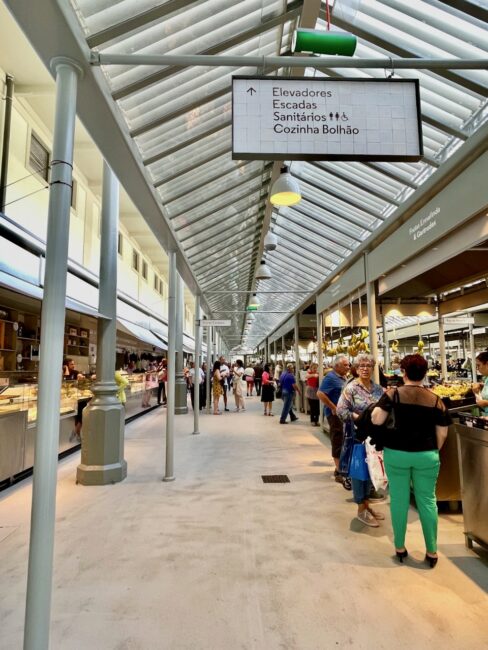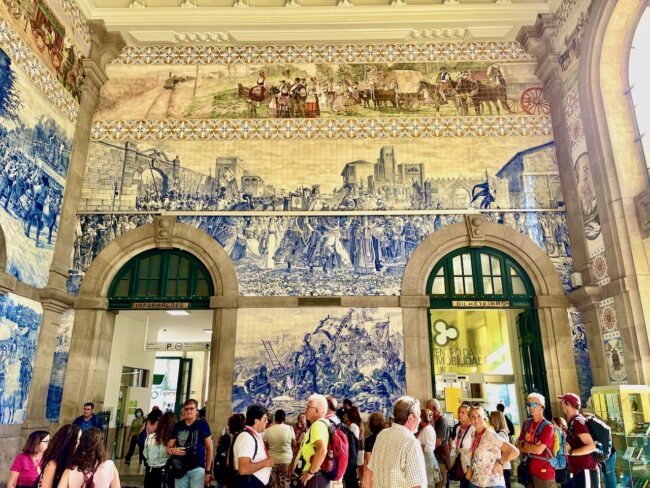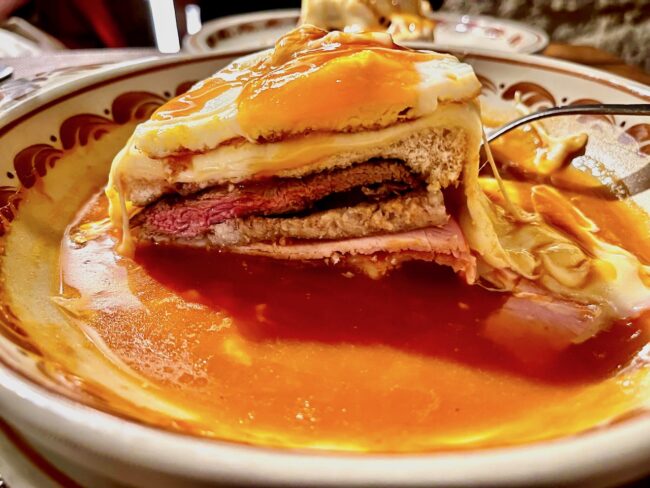
Chapter Fifteen: Rolling On The Douro
March 1, 2023
Chapter Seventeen: Historic Porto Sites and Beautiful Porto Sights
March 21, 2023Falling For Portugal: A Mai Tai Tom “Trip” Report
Chapter Sixteen: Enjoying Energizing Porto
Day Eighteen: You Don’t Bring Me Flowers, It’s Almost Like I Know You, Garden Setting, The Surprise Around The Corner, Ildefonso, On Track For Tiles, You Can’t Fight City Hall, Heart Attack On A Plate and a Majestic Cafe
Our four nights in the Douro had ended. In retrospect I believe three nights and two full days would have been the better option, however with Kim under the weather, it probably turned out as well as could be expected. We careened one last time down the wonderful Quinta do Pego Grand Prix course (fortunately we never met a car in the opposite direction), and we were off to our final destination … Porto.
Bidding farewell to the Karen Valentine Highway, we hit a toll or two and remembered to stay in the Via Verde (Green Lane) whenever those toll signs popped up. I can still hear the ding of our transponder.
A friend had recommended we check out Amarante, but after getting shut out of parking, we then encountered a little “Flower Madness” as we found ourselves stuck behind a flower delivery truck on a narrow street. As I waited patiently (or as patiently as anyone from Los Angeles could be), time kept ticking away. I was in my “Euro Tom” mood, so no cursing or horn blowing occurred. Finally, the flower lady re-emerged and we were on our way trying to keep that annoying Barbra Streisand/Neil Diamond song out of our heads.
Safely arriving at the Porto Airport without somehow damaging the car over the past nine days, we dropped it off and Ubered to the In Porto Gallery Guesthouse (Rua do Bonjardim 358, 4000-116), which turned out to be in a great location.
At the front desk I finally met Cátia, who I had been corresponding with since 2019. “I feel like I know you,” she said. Thankfully the Guesthouse had survived Covid, and we were shown to our rooms up one flight of stairs at this charming boutique lodging. There’s a quaint breakfast room and a peaceful garden with a covered deck where we enjoyed some wine on a few occasions during our stay.
Cátia gave us some helpful pointers on navigating Porto, and since we were ravenous, told us about a fantastic restaurant nearby that catered primarily to locals. We took to the street and within two blocks not only had we forgotten the name of the restaurant, but also her expert directions (we would eventually make it there later in the week). Apparently none of us are good listeners.
Wandering aimlessly, which very well could be a headline for each of these chapters, we happened upon Garden Porto (Rua de Fernandes Tomás 985), an eatery that took us 20 minutes to discover, although it is logistically only a three-minute walk from the In Porto Gallery Guesthouse. At least we got to see some cool street art on our rambling journey (this one by street and tattoo artist Nuno Costah, aka Costah, whose work can be seen throughout Porto) …
The ambiance seemed good …
… and the service turned out too be very friendly (as most all places were in Portugal). I had a delicious mac & cheese with Kimchi vegetable soup, while Tracy opted for a chicken burger. Mary went for the pulled pork burrito, while Kim had the odd pairing of mac & cheese with a croissant (he’s still trying to get those taste buds back).
After lunch, we first stopped back at our lodging where Cátia had us write down the name of the restaurant we had forgotten. Kim and Mary stayed behind to rest, while Tracy and I explored Porto. The streets were crowded. I guess I’m a city person, because I love the buzz of a busy metropolis.
Our first stop was a building virtually around the corner. The Beaux-art style Mercado do Bolhão (Rua Formosa, 4000-214) opened originally in 1914 and has had many iterations since. Even before the building was constructed, merchants were selling their fruits and vegetables at this location.
Due to building falling into near disrepair, in the 2000s there were plans to construct a luxury hotel with offices on the site, but the citizens of Porto had other ideas. In 2015 a refurbishment project commenced and knowing the four of us were going to be in town in October, just a few weeks before we arrived, the neoclassical building reopened for business. Timing baby! Tracy and I wandered the market, perusing the stalls full of fresh produce.
It looked like it was winding down a bit at 4 p.m., but still there lots of people and the market had a good feel about it.
Sometimes I really wish I didn’t like pork so much.
Tracy, of course, found a floral booth.
It had been awhile since we’d seen some sardines. We decided we’d return with Kim and Mary another day to explore more.
Along R. Formosa lots of people were shopping …
Speaking of shopping, we made a right at Rua de Santa Catarina, a mostly pedestrian street with tons of stores and dining options.
We’d return to this street after dinner to sip wine at a famous café, which was very busy this late afternoon.
Buildings throughout Porto are colorful.
Not too far away, near Batalha Square, we admired the 18th-century Igreja de Santo Ildefonso, with its incredible façade featuring about 11,000 azulejo tiles. I’d seen pictures before we left, but it was even more spectacular in person. The wall tiles were painted by Jorge Colaço in 1932, who was famous for his painting on azulejo. We’d check out more of Colaça’s work at our next stop.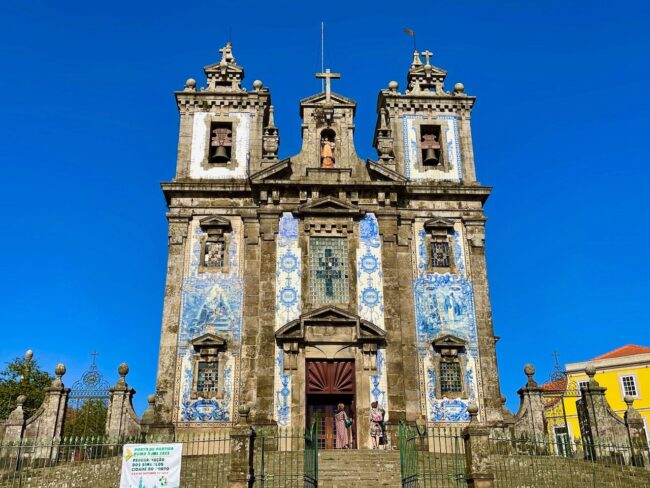
The Baroque and Rococo altarpiece dates to 1745 …
… while the numerous stained glass windows were installed during the 20th century.
We also ran into a few saints in its museum.
If there’s a church … there’s a ceiling.
 As we left, we noticed that atop the church the flag of Portugal was standing proudly.
As we left, we noticed that atop the church the flag of Portugal was standing proudly.
Walking to our next destination, we ran across someone who needed a little love.
Less than a ten-minute walk and a tempting store …
… we were at the train station, but not your normal train station.
Built in 1900, the São Bento Railway Station contains “20,000 magnificent azulejo tin-glazed ceramic tiles depicting Portugal’s past – its royalty, its wars, and its transportation history.” Once again, this was the work of Jorge Colaço.
It took him 11 years to complete the task (1905 – 1916). Usually when a train station has lots of people, they’re traveling somewhere, but today they were admiring Colaço’s work.
This azulejo, if my Portuguese translation is correct, depicts 12th-century nobleman Egas Moniz presenting himself with his wife to the King of León. There’s a long story to it that’s rather interesting (Google is your friend.)
Above it is a panel depicting the Battle of Valdevez in 1140
This one shows the Conquest of Ceuta in 1415.
Above it, the knight Egas Moniz and Alfonso VII of León (12th century) meet.
We spent a good deal of time looking at the tiles …
 … although some people were actually traveling.
… although some people were actually traveling.
I was really looking forward to walking back to the hotel via Porto’s grand avenue, but the beginning of the Avenida dos Aliados was under repair, so this was all I saw of the statue of King Pedro IV (aka Emperor Pedro I, of Brazil).
As we walked up the 330 yards to Porto’s City Hall, we could see why this street, named in honor of Portugal’s World War I allies, is so famous. Lovely Belle Epoque buildings line each side of the boulevard.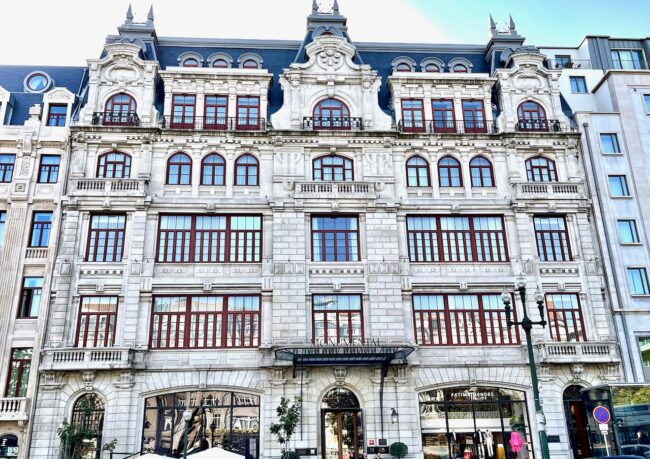
At one time gardens decorated the center of the avenue, but when construction on the subway happened in the early 2000s, a rectangular pool was installed but it makes for a picturesque spot, as well.
The neoclassic Porto City Hall’s construction began in 1920, but was not completed until 1957 (sounds like the same crew who worked on a new kitchen in my first house).
In front of the city hall is the bronze Monumento Almeida Garrett, dedicated to Portugal’s famous writer. As for me, I believe I was sitting on a period piece.
Back at In Porto Gallery Guesthouse, it was time to freshen up and go out to dinner. No nap today. Sorry Tracy.
Porto is famous for its iconic francesinha (aka Heart Attack On A Plate). Before leaving on our trip I had contacted Cátia and asked where could we find the best one in town. Without reservation, she recommended Cervejaria Brasão Aliados (Rua de Ramalho Ortigão 28). She said to get online reservations, because it is always crowded. She was correct. This is just one of the Brasão group of restaurants but Cátia said this was the first … and the best.
It opens at 7 p.m., and we had made a reservation for 7 p.m. When we arrived, it looked like half of Porto was waiting to get in, as you could see by my look of despair.
It was short-lived despair, because most all of the people in line did not have a reservation and before you could say decadent cheese sandwich our name was called.
We were seated upstairs and the restaurant was energetic without being overly loud for conversation.
I was here for one thing and one thing only, the famed francesinha. The description I read before I left was: “Born in Porto, the traditional francesinha sandwich manages to stuff two types of homemade sausage, ham, steak, bologna, and cheese between two thick layers of bread; that’s then topped with a fried egg and beer gravy and served surrounded by fries intended for dipping.” My Expando Belt was going to have a great workout fighting to keep my pants buttoned. After we saw the sandwich delivered to a nearby table, Tracy and I wisely decided to share one (10,000 calories is usually my limit at a meal). It was very good, and not keeling over during dinner was an added bonus.
And why not have a beer or two to wash it down?
Afterward we walked to the Instagram-friendly City Hall.
I love that Portugal has these cool city signs.
We checked out the buildings glimmering in the darkness.
Kim and Mary went back to the hotel, while Tracy and I decided to wander the Rua de Santa Catarina and visit the café that had been so busy that afternoon.
Arriving a little before 9:30, the Art Nouveau Café Majestic was pretty quiet except for the strains of a violinist playing outside. Café Majestic transports you back to another time, like a 1920s salon. 
We gazed at the large Flemish mirrors on the walls as we settled into our wood-carved chairs at the marble-topped table.
It has a very Parisian feel to it. It’s been here since 1921, but by the 1980s it had deteriorated. The café was then renovated to its past grandeur, and since 1994 it has been welcoming locals and tourists to sip coffee, or in our case, have a couple of glasses of wine.
We strolled along the now nearly vacant Rua de Santa Catarina …
… saw a very decked out in colored lights store …
… took a peek inside the vacant Mercado do Bolhão and were soon back at In Porto Gallery Guesthouse.
Tomorrow on our first full day in Porto, we’d revisit São Bento Railway Station with Kim and Mary and then stroll along “The Road of Flowers” toward the River Douro. We would eventually take a tour of the ornate Palácio da Bolsa and visit the nearby Igreja de São Francisco.
 Crossing the River Douro to Vila Nova de Gaia, we’d sample traditional Portuguese cuisine for lunch and hit two of the most touristy (but photographical) spots on the trip. We’d eschew the Teleférico de Gaia, but did enjoy one of the shortest boat rides I’ve ever taken. We would once again pay our respects to Henry The Navigator, have wine in our backyard with some friendly cats and finally have a dinner where I would get skewered.
Crossing the River Douro to Vila Nova de Gaia, we’d sample traditional Portuguese cuisine for lunch and hit two of the most touristy (but photographical) spots on the trip. We’d eschew the Teleférico de Gaia, but did enjoy one of the shortest boat rides I’ve ever taken. We would once again pay our respects to Henry The Navigator, have wine in our backyard with some friendly cats and finally have a dinner where I would get skewered.
Next: Chapter Seventeen: Porto Palace
Day Nineteen: On Track For Even More Azulejos, Strolling On The Road Of Flowers, Taking Stock Of A Palace, Are We At The Alhambra, No Photos Of Francis, Crossing The Douro, Cheesy But Fun, Mary Renders Aid, Henry (Again), The Well-Situated Wine Store, Feline Friends and Skewered!















